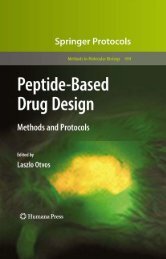You also want an ePaper? Increase the reach of your titles
YUMPU automatically turns print PDFs into web optimized ePapers that Google loves.
220 Singer and Hoffmann<br />
3. Whereas the scavenger mixture can be stored for one month, the reagent mixture<br />
with TFA should be prepared fresh for each cleavage.<br />
4. The three-letter code used for all amino acids refers always to the corresponding<br />
l-amino acids. d-Enantiomers are abbreviated by d- followed by the corresponding<br />
three-letter code, such as D-Ser for D-serine.<br />
5. Store all amino acid derivatives and activation reagents dry at 4 ◦ C in the darkness<br />
in aliquots of 25 g or less. Before opening a container, place the derivatives in<br />
the laboratory for at least 2 h to reach room temperature. Thus the derivatives<br />
stay dry even when opened several times at higher humidity. Dissolve all solid<br />
compounds just before starting the synthesis without prolonged storage. It should<br />
be noted that amines are formed slowly in DMF in the presence of water traces.<br />
Therefore it is important to store DMF under nitrogen atmosphere or to consume<br />
it within 1 wk. We use older DMF only to dilute piperidine.<br />
6. It is important to use amidite reagent, 1 H-tetrazole, and all solvents for the<br />
phosphitilation step of high purities and to keep all vials and solutions dry.<br />
Thereby, many by-products described in the literature for the global amidite<br />
approach (i.e., H-phosphonopeptides, dimers, etc.) can be omitted yielding the<br />
corresponding peptides in high purities accompanied only by species with lower<br />
phosphorylation degrees.<br />
7. All buffers and solutions were prepared in desalted water with a conductivity<br />
below 18.2 mS and a total organic content below 2 ppb (parts per billion) using<br />
a ELGA PURELAB Ultra system (ELGA LabWater, Celle, Germany).<br />
8. Eluents should be filtered through a 0.2-�m filter (GH Polypro, Hydrophilic<br />
Polypropylene membrane filter, Pall Life Sciences, Ann Arbor, MI) and stored<br />
in clean glass bottles for less than 1 mo. Solvents should be degassed by vacuum<br />
(1 mbar) for 1–2 min if a low-pressure gradient mixture is used (do not use longer<br />
times to minimize loss of TFA and acetonitrile). For high-pressure gradient<br />
HPLC systems this degassing is not necessary if a backpressure valve is used<br />
after the detector to prevent formation of air bubbles in the detector cell.<br />
9. As acetonitrile has a higher absorption than water at 220 nm, the UV trace<br />
slightly climbs with increasing acetonitrile content. Whereas this linear climb of<br />
the background is a good measure for judging the reproducibility of the formed<br />
gradient, it can be advantageous to compensate it by reducing the TFA content<br />
in eluent B to 0.09%. If 100% acetonitrile is used as eluent B, the TFA content<br />
should be further decreased to 0.085%. The resulting stable base line is especially<br />
useful to analyze small peptide amounts with low signal intensities.<br />
10. For most crude peptides a linear increase of 3% per min eluent B is sufficient to<br />
separate the target peptide from all by-products. In order to obtain high purities<br />
and load larger sample amounts on the preparative column use a linear increase<br />
of only 1% per min eluent B at least 10 min before and after the targeted peptide<br />
elutes. Calculate the retention time on the preparative column from the retention<br />
time of the analytical separation using the known dead volumes of the system<br />
and the different flow rates.<br />
11. To distinguish peptides and partially protected peptidic by-products carrying an<br />
aromatic protecting group (e.g., Fmoc, benzyl), it is advantageous to record the






